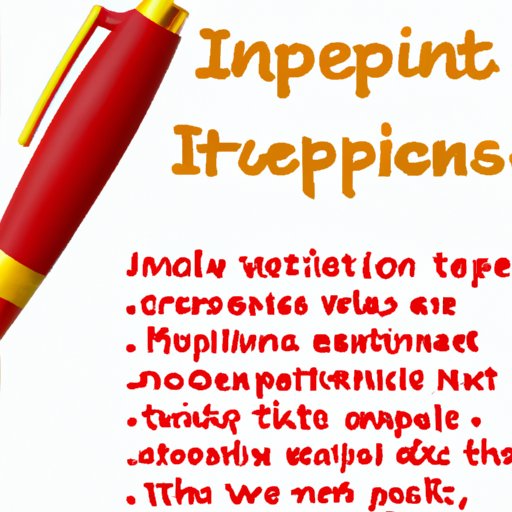Introduction
Descriptive writing is a form of communication that allows the writer to convey ideas, feelings, and experiences through the use of words. Through descriptive writing, the writer can create a vivid picture in the reader’s mind by using sensory details, figurative language, and other literary devices. The main purpose of descriptive writing is to communicate effectively and evoke emotion in the reader.
Definition of Descriptive Writing
Descriptive writing is the use of words to create a vivid image or picture in the reader’s mind. It involves the use of sensory details, figurative language, and other literary devices to help the reader imagine or experience what the writer is describing. Descriptive writing is often used in literature, journalism, advertising, and other forms of communication.
Benefits of Descriptive Writing
Descriptive writing has many benefits. By using descriptive writing, the writer can create a vivid image in the reader’s mind. This can help the reader connect with the subject matter on a deeper level. Descriptive writing also allows the writer to evoke emotion in the reader. It can be used to make the reader feel joy, sadness, anger, fear, or any other emotion. Finally, descriptive writing can help clarify complex concepts and provide clarity to the reader.
Types of Descriptive Writing
There are several types of descriptive writing techniques. Personification is the use of human characteristics to describe non-human things. Similes and metaphors are comparisons between two unlike things. Imagery is the use of vivid descriptions to create a mental image. Onomatopoeia is the use of words that imitate sounds.

Role of Descriptive Writing in Communication
Descriptive writing plays an important role in communication. It helps the writer create a picture in the reader’s mind. By using descriptive words and phrases, the writer can make the reader “see” what he or she is describing. Descriptive writing can also be used to evoke emotion in the reader. Through the use of sensory details, figurative language, and other literary techniques, the writer can create a strong emotional response in the reader.
Finally, descriptive writing can help provide clarity to the reader. By using descriptive words and phrases, the writer can explain complex concepts in a way that is easy to understand. This can help the reader better comprehend the subject matter.

Utilizing Descriptive Writing for Creative Expression
Descriptive writing can also be used for creative expression. Writers can use descriptive writing to describe a scene. Vivid descriptions can help the reader imagine being in the scene and experiencing it first-hand. Descriptive writing can also be used to craft characters. By using descriptive words and phrases, the writer can create a vivid picture of the character in the reader’s mind. Finally, descriptive writing can be used to create mood and tone. By using carefully chosen words and phrases, the writer can set the mood and tone of the story.
Crafting a Descriptive Writing Piece: Tips and Tricks
Writing a descriptive writing piece can be challenging. Here are some tips and tricks to help you get started:
Brainstorming Ideas: Before you start writing, take some time to brainstorm ideas. Think about what you want to write about and come up with some ideas. Once you have some ideas, you can start writing.
Choosing Words Carefully: When writing a descriptive writing piece, it’s important to choose your words carefully. Make sure to use words that will create a vivid image in the reader’s mind. Also, try to avoid using clichés.
Show, Don’t Tell: Instead of telling the reader what is happening, show them. Use sensory details and figurative language to help the reader imagine the scene. This will help create a stronger connection between the reader and the story.
Pay Attention to Detail: Pay attention to small details when writing a descriptive writing piece. Even small details can help create a vivid image in the reader’s mind. Try to include as many details as possible.
Conclusion
Descriptive writing is a powerful form of communication. It allows the writer to create a vivid picture in the reader’s mind, evoke emotion in the reader, and provide clarity to the reader. Descriptive writing can also be used for creative expression, such as describing a scene, crafting characters, and creating mood and tone. By following the tips and tricks outlined in this article, you can craft a descriptive writing piece that will captivate your readers.
(Note: Is this article not meeting your expectations? Do you have knowledge or insights to share? Unlock new opportunities and expand your reach by joining our authors team. Click Registration to join us and share your expertise with our readers.)
